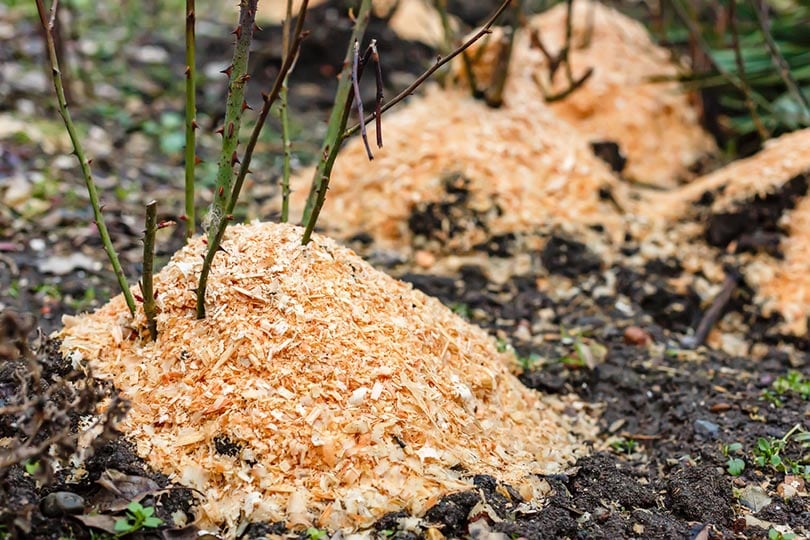How Much & How Often to Water Roses: A Complete Guide
-
Ashley Bates
- Last updated:

The hallmark of Valentine’s Day and other romantic gestures, the rose is really a prized possession. Roses are one of the most beloved flowers of gardeners everywhere. They are renowned for their exquisite beauty and distinct scent. So you might want to know just how to make the most out of your rose plants this year.
After all, the amount of water your plants get really makes a difference in their overall growth. You won’t want to underwater or overwater—so we’re glad you’re here to learn more about how to keep your roses healthy and hydrated.

Watering Roses
You might notice that your roses develop beautiful, colorful, lustrous blooms in the spring months. In the summer months, it might seem as though the blooms are slightly less vibrant or large. Watering plays a huge role in ensuring that your roses produce beautifully yearly.
Roses require moist, well-draining soil all throughout the summer months. Since droughts and infrequent rainfall are widespread in some summertime stages, keeping up with watering is a must. Your roses might not get the moisture they need to thrive the best if they dry out.
Other factors also come into play—such as surrounding plants, soil type, weather, and temperature. Roses absolutely love water and thrive better in moist environments.
The more you ensure proper watering and fertilization, your blooms will be larger and more colorful.

How Much to Water Roses
Your roses typically need two inches of rainfall per week. That translates to roughly four to five gallons of water. Don’t worry too much if your roses got a little extra—they love water! If natural resources aren’t available, it is time to do the job yourself.
Just be careful not to overwater them to prevent root rot and other issues.
How Often to Water Roses
When it comes to watering yourself, you have to keep it up. If rain is doing most of the hard work for you, there is no need to over-saturate. However, if you’re experiencing regular summer dry spells, be sure to really keep up with it.
As we mentioned above, your roses require roughly four to five gallons of rainfall per week—so, make up for that if the weather is lacking. Also, windier weather, sandy soils, and very dry climates can call for an increase.
How to Conserve Water for Your Roses
If you love landscaping, this one should excite you. You can select something that will help the soil retain moisture, like sawdust, newspaper, wood mulch, and herbicide-free grass clippings. You just need to add a layer down of your chosen mulch.
The entire idea is to keep the soil moist without quickly drying out— this is especially important for sandier soils.

Planting Roses
When you plant your roses, it’s best to plant them in an area with lots of sunlight and natural moisture. But if you plant the bushes in drier soil, you must water your roses adequately to ensure proper growth.
So, get your hoses and watering cans ready. You have to give your thirsty roses lots of nutrients to make them flourish.
Containers Matter
Roses don’t grow in containers well, as they love their space to reach roots and flourish. If your roses are in a container temporarily, do not let the soil get dry. Keep the soil moist—but not saturated.
It would be best if you didn’t let your roses dry out. If you are trying your hand at growing miniature roses indoors, always follow the care tips for that specific species. Indoor care for roses is much different and requires a different approach.
Most of the time, if you buy pre-grown rose bushes or cuts, they should be planted into the soil as soon as temperatures outdoors permit doing so.

Rose Care Tips
Caring for roses really isn’t that difficult. It is what you make it. You are in control of having the most lustrous blooms or just the average yearly yield.
Types of Roses
Gardeners really explored different types of roses—from hybrids to classics.
- French rose
- White Rose of York
- Bourbon Rose
- Floribunda
- Rosa Grandiflora Group
- Polyantha
- Hybrid Tea Rose
- Knock Out
- China Rose
- Peace rose
- Moss-Rose Purslane
- Lincoln
- Julia Child Rose
- Beach Rose
- Rosa Queen Elizabeth
Always check your specific rose variety to see if there is any specific care they require.

Soil pH
The ideal pH for roses is between 6 and 6.5. If it goes above or below this standard, it can mean there are too many or too few nutrients in the soil, directly interfering with the pH your roses require. You can easily check soil pH before planting with market products.
Lighting
Roses thrive best in direct sunlight. At a minimum, they require at least four hours of direct sunlight per day—but can thrive in six to eight hours of light. So, plant your roses on the sunnier side of your house and place shade-tolerant plants elsewhere.
Fertilizer
Your roses would benefit greatly from fertilizer. It gives the soil the boost of nutrients it needs to create a healthier bush. Obviously, organic compost and manure can be terrific fertilizer choices. But you can also buy commercial fertilizers available in the store.

Conclusion
So, just remember that your roses love water. They don’t thrive as well or bloom as beautifully when they don’t get at least four to five gallons of water per week. These plants love nutrient-rich, well-draining soil.
Remember, when you’re watering your roses, consider the weather you are having. Less rain equals more supplemental watering. Also, are there any plants near your roses that are real water hogs? That’s important, too.
Ultimately, you’ll need to ensure your roses get at least two inches of water per week and more if needed.
Featured Image Credit: Norma Stamp at Sunny Daze, Shutterstock
Contents
